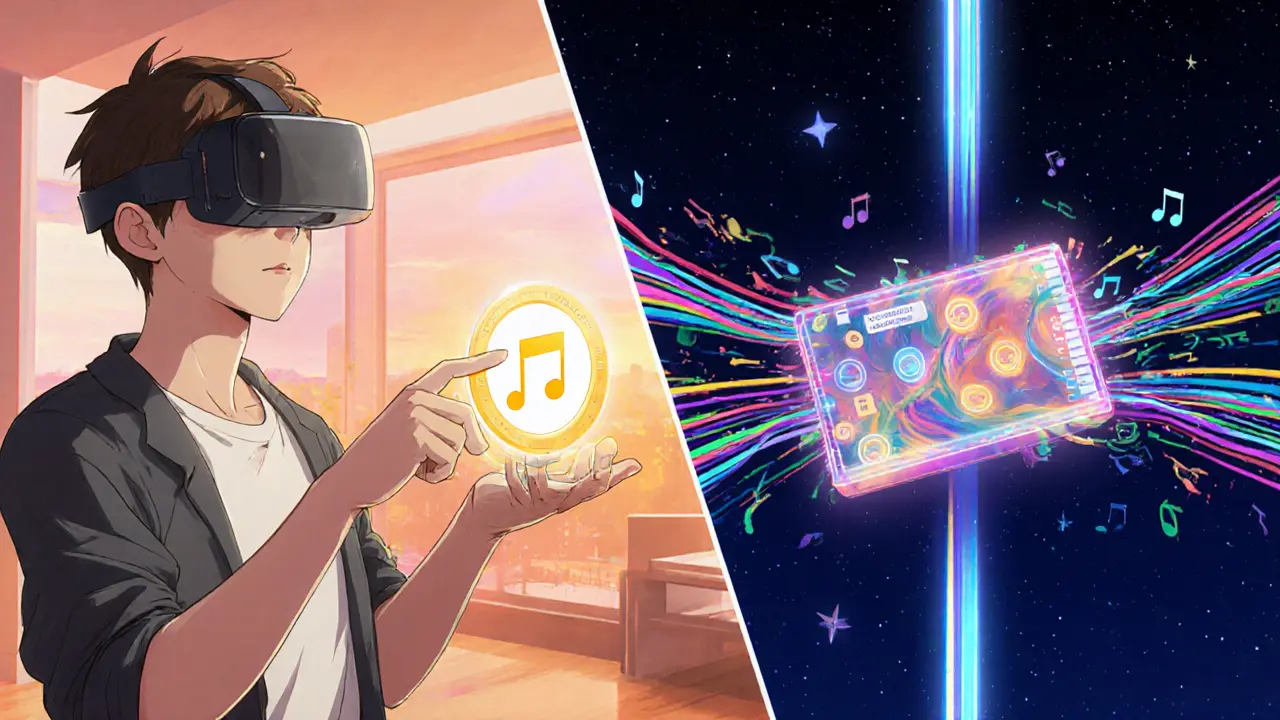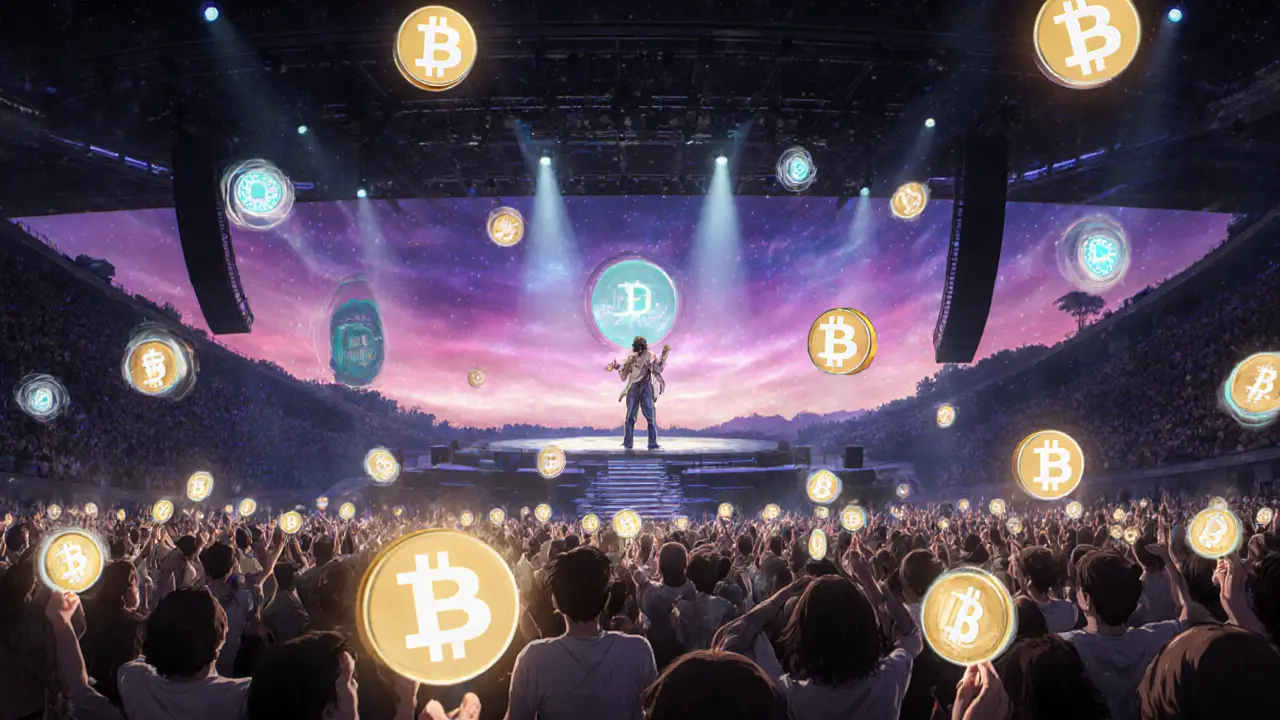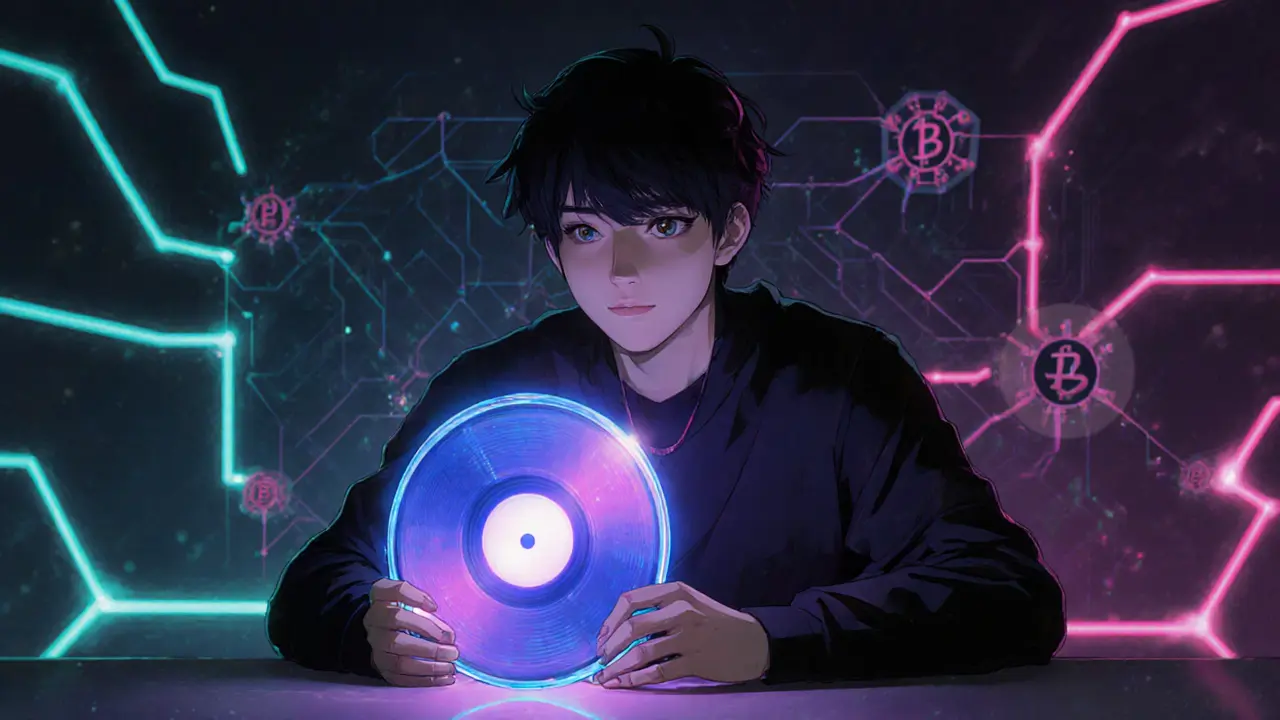Music NFT Explorer
What Are Music NFTs?
A unique blockchain-based token representing ownership of a piece of music. It combines digital ownership with potential revenue sharing and community engagement.
Key Benefits
Verifiable ownership, ongoing royalties, exclusive fan experiences, and potential for appreciation in value.
Comparison Table
| Aspect | Music NFT | Streaming Subscription | Digital Purchase (MP3) |
|---|---|---|---|
| Ownership | Verified, unique token on blockchain | Access rights only | File ownership, but easy to copy |
| Revenue Share | Often includes royalty splits via smart contract | Flat payout to label/artist per stream | One-time purchase price |
| Fan Interaction | Direct community, exclusive drops, governance | Limited to playlists and comments | None after purchase |
| Resale Potential | Can be sold on secondary markets | Not applicable | Generally non-transferable |
| Access Rights | Anyone can stream, owner holds unique collectible | Requires subscription | File can be played offline anytime |
Types of Music NFTs
Single-track NFTs
One token represents a single song, often paired with exclusive artwork or behind-the-scenes content.
Album Bundles
Collection of tracks minted as a single token, sometimes with bonus content like videos or merchandise.
Generative Music NFTs
Token contains an on-chain algorithm that creates a unique composition each time it's played.
Experience NFTs
Combine a song with a concert ticket, virtual meet-and-greet, or limited-edition merchandise.
Key Considerations
For Artists
- Direct fan funding without labels
- Transparent royalty distribution
- Engage with loyal fanbase
- Re-engage older catalog
For Fans
- Exclusive community access
- Potential for appreciation
- Voting rights on future releases
- Status symbol within community
- Requires crypto wallet and basic blockchain knowledge
- Environmental impact varies by blockchain used
- Market prices can be volatile
- Legal status of ownership is still evolving
When we talk about Music NFT a unique blockchain‑based token that represents a piece of music, we’re looking at a fresh way to own, trade, and profit from digital songs.
How Music NFTs Work
At the core of every Music NFT lies a blockchain ledger. The blockchain stores a token ID, a contract address, and metadata that points to the actual audio file, video, or interactive experience. This metadata can live on decentralized storage services such as IPFS, ensuring the file remains accessible even if the original host disappears.
A smart contract governs the token’s behavior. It defines who can mint new tokens, how royalties are split, and whether the owner can transfer or burn the NFT. Because the contract code is immutable, the ownership record can’t be altered or forged, giving fans a verifiable proof of ownership that’s permanently anchored in the network.
Ownership vs. Streaming vs. Traditional Purchase
Most music fans are used to two models: streaming services that grant listening rights, and digital downloads that provide a copy but not true ownership. Music NFTs blend the best of both worlds-anyone can stream the underlying track, but only the token holder possesses the unique, tradeable asset.
| Aspect | Music NFT | Streaming Subscription | Digital Purchase (MP3) |
|---|---|---|---|
| Ownership | Verified, unique token on blockchain | Access rights only | File ownership, but easy to copy |
| Revenue Share | Often includes royalty splits via smart contract | Flat payout to label/artist per stream | One‑time purchase price |
| Fan Interaction | Direct community, exclusive drops, governance | Limited to playlists and comments | None after purchase |
| Resale Potential | Can be sold on secondary markets | Not applicable | Generally non‑transferable |
| Access Rights | Anyone can stream, owner holds unique collectible | Requires subscription | File can be played offline anytime |
Monetization and NFT Royalties
One of the biggest draws for artists is the ability to embed royalties directly into the token’s code. Platforms like Opulous let fans buy a Music NFT and automatically receive a percentage of future streaming revenue. This creates an ongoing financial relationship rather than a one‑off sale.
Because the royalty terms are immutable, fans know exactly what they’re getting, and artists can sidestep the traditional label model where a large cut of earnings goes to intermediaries. In practice, a typical royalty split might allocate 10‑15% of streaming income to NFT holders, while the rest goes to the creator and any collaborators.
Types of Music NFTs
Music NFTs aren’t a one‑size‑fits‑all product. Here are the most common formats you’ll encounter:
- Single‑track NFTs: One token represents a single song, often paired with exclusive artwork.
- Album bundles: A collection of tracks minted as a single token, sometimes with bonus content like behind‑the‑scenes videos.
- Generative music NFTs: The token contains an on‑chain algorithm that creates a unique composition each time it’s played. This merges code and art in a way traditional recordings can’t match.
- Experience NFTs: Combine a song with a concert ticket, virtual meet‑and‑greet, or limited‑edition merchandise.
Each type leverages the same blockchain foundation but offers different value propositions for collectors.

Why Artists Love Music NFTs
Indie musicians can fund new projects by selling NFTs directly to fans, cutting out the need for a record label advance. The transparent royalty model also means they keep a larger slice of every subsequent stream. Moreover, NFTs serve as a loyalty badge-owners often become super‑fans who promote the artist’s work organically.
For established acts, NFTs provide a fresh revenue stream and a way to re‑engage older catalogs. By releasing a limited‑edition NFT of a classic track, they can spark renewed media attention and drive secondary‑market sales.
What Fans Gain
Fans get more than a digital file. Ownership signals status within a community, unlocks exclusive Discord channels, and may even grant voting rights on future releases. Some projects let NFT holders decide which remix appears on the next EP, turning fans into co‑creators.
Beyond bragging rights, NFTs can appreciate in value. If an artist skyrockets in popularity, early supporters may sell their tokens for a profit, similar to how classic vinyl records appreciate over decades.
Challenges and Considerations
Despite the hype, there are real hurdles:
- Technical barrier: Buying a Music NFT requires a cryptocurrency wallet, some familiarity with gas fees, and a basic understanding of blockchain transactions.
- Environmental concerns: Proof‑of‑work blockchains consume a lot of energy. Many platforms are migrating to proof‑of‑stake or layer‑2 solutions to lower their carbon footprint.
- Market volatility: NFT prices can swing wildly. Collectors should treat purchases as both an artistic and speculative investment.
- Legal gray area: Copyright laws vary by jurisdiction, and it’s still unclear how ownership of a token translates to rights over the underlying music.
These factors mean the average listener may wait for more user‑friendly experiences before diving in.
The Future of Music NFTs
We’re seeing a gradual convergence of Web2 and Web3. Major streaming services are experimenting with NFT integration, allowing artists to attach a token to a regular release without forcing fans to leave their familiar apps. Meanwhile, new marketplaces are building drag‑and‑drop tools that let anyone mint a Music NFT in under five minutes.
Regulatory clarity and greener blockchain solutions will likely accelerate mainstream adoption. If these pieces fall into place, Music NFTs could become a standard part of an artist’s release strategy-much like a deluxe edition or a limited‑run vinyl.
Key Takeaway
Music NFTs aren’t just a gimmick; they’re a technical layer that adds verifiable ownership, ongoing royalties, and community engagement to digital music. Whether you’re an artist looking for new revenue streams or a fan craving deeper connection, understanding how these tokens work is the first step toward the next era of music.

Frequently Asked Questions
What exactly does a Music NFT give me as a buyer?
You receive a unique token that proves you own a specific piece of music. The token may also grant access to exclusive content, royalty shares, or special experiences, depending on how the creator set it up.
Do I need to be a crypto expert to buy a Music NFT?
You’ll need a simple cryptocurrency wallet and a small amount of ether or other native token to cover transaction fees. Many platforms now offer guided onboarding that walks you through the steps.
Can I still listen to the song if I don’t own the NFT?
Yes. Most creators make the audio file publicly streamable on platforms like Spotify or YouTube. Ownership merely adds the collectible and any extra perks.
How are royalties handled for Music NFTs?
Royalty percentages are coded into the smart contract. When the song generates streaming revenue, the contract automatically distributes the predefined share to every token holder’s wallet.
Is buying a Music NFT a good investment?
It can be, if the artist’s career grows and the token’s scarcity remains high. Treat it like buying any collectible: enjoy the artistic value first, and view potential financial gains as a bonus.


Post Comments (17)
Loved the guide! 🎉 Music NFTs are the future and you explained it super clearly. Can't wait to dive in!
Music NFTs are tokens on a blockchain that give you verifiable ownership and built‑in royalty splits. They let anyone stream the track while only the token holder owns the collectible.
Hey folks, just wanna say that if u wanna start buying these NFTs, get a wallet like MetaMask and a little eth. It’s not rocket science, and the community is super supportive!
Nice rundown of NFTs. Simple and clear.
OMG this whole NFT hype is like the wildest rollercoaster ever! Everyone’s shouting about ownership, but do they really get that it’s just code on a screen? It's a revolution and a nightmare rolled into one!
Esteemed readers, I must commend the thoroughness of the exposition-though I note a minor oversight regarding the environmental impact of Proof‑of‑Work chains 😅. Nonetheless, the content provides a robust foundation for further inquiry.
Let's cut the fluff-Music NFTs are just another speculative bubble dressed up as art. The tech won't fix the underlying exploitation in the music industry.
Oh great, another crypto fad to waste my time. Because what the world really needed was another way to pay fees to mint a useless token.
One must consider the meta‑narrative: the commodification of auditory experiences via decentralized ledgers is not merely a market trend but an epistemological shift in cultural consumption, albeit riddled with scalability concerns.
Music NFTs are just hype.
No, you’re missing the point-while hype exists, the direct fan‑artist revenue model is a game‑changer and deserves serious consideration!
From a blockchain interoperability standpoint, the tokenization of audio assets leverages ERC‑721 standards to instantiate non‑fungible identifiers, thereby enabling secondary market liquidity and provenance tracking within decentralized exchanges.
In accordance with established intellectual property frameworks, the issuance of a Music NFT constitutes a transferable digital right that is recorded immutably on a distributed ledger, thereby providing incontrovertible proof of authenticity; this mechanism simultaneously facilitates automated royalty disbursement via smart contract clauses, ensuring that each stakeholder receives a predetermined percentage of revenue streams, which, when aggregated across platforms, enhances fiscal transparency and mitigates intermediary latency.
Music NFTs open a new door for fans who want more than just listening.
They give you a badge that shows you own something special.
That ownership is recorded on a blockchain, so no one can fake it.
Artists can set up smart contracts that send a slice of streaming money back to token holders.
This creates an ongoing relationship rather than a one‑time purchase.
Because the token is unique, you can trade it on secondary markets if you wish.
Some collectors see these tokens as investments that could grow in value.
Others enjoy the exclusive content like behind‑the‑scenes videos or private Discord access.
The technology also lets artists re‑release old tracks with fresh incentives for longtime fans.
However, there are barriers such as needing a crypto wallet and paying gas fees.
Environmental concerns are also being addressed by newer proof‑of‑stake chains.
Market volatility means prices can swing wildly, so buying should be done thoughtfully.
Legal questions about what rights you actually own are still being worked out.
Despite the challenges, many independent musicians have funded entire albums through NFT drops.
Listeners who feel part of a community often become vocal advocates for the artist.
Overall, Music NFTs blend technology and creativity in a way that could reshape how we experience and support music.
Indeed, the integration of NFTs into music platforms presents exciting opportunities!!! However, it is essential to educate users about wallet setup, gas fees, and security measures; otherwise, we risk user frustration!!!
Yo! This whole NFT thing is kinda cool, but don’t forget the music itself is still king, right?
The proliferation of Music NFTs is a clear symptom of speculative excess, and the market will self‑correct-mark my words 🚀📉.